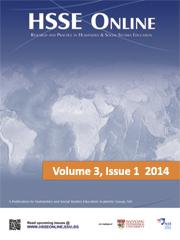A Note from the Editor
Thinking is not the intellectual reproduction of what already exists… Open thinking points beyond itself. Theodor Adorno (1998, pp. 291-292)
As Susan Adler notes in this issue, we’ve been hearing for some time now that we have to do school differently. But we still seem mired in traditional or outmoded school cultures, classroom practices, and ways of thinking about education and society. Sir Ken Robinson’s popular video on educational paradigms raises the notion that current systems of education remain grounded in Enlightenment and Industrial Revolution-era modes of thinking that still prioritize rationalization (classifying, categorizing, sorting, etc.), standardization, competition and consumption, hierarchical authority structures, and the supervision, monitoring and regulation of teachers and students. Robinson argues that this industrial model of education tends to lead to conformity, standardized curriculum and assessment, and an input-output model of teaching and learning. These ways of thinking and the educational structures and practices they seem to perpetuate may not help prepare young people for the 21st century, despite the best intentions of reform efforts.
Indeed, we live in a rapidly changing global society in which more information and technological solutions have done little to address persistent social, political, and economic problems, such as climate change, war, terrorism, and other forms of organized violence, or deep-rooted forms of inequality and injustice. What seems to be needed more than ever are new ways of thinking. As Grace Lee Boggs (1998) notes in Living for Change, “All over the world today we are obviously living in that in-between period of historical time when great numbers of people are aware that they cannot continue in the same old way but are immobilized because they cannot imagine an alternative.” Boggs sees this as an opportunity to look at ourselves and reorder our priorities. She believes people can develop grassroots or local strategies that have the potential to transform social practices, ways of thinking, and our sense of political and social responsibility to each other.
The articles in this issue call for new ways of thinking about educational practice and social issues. In their own way, each author suggests new ways of thinking that can transform social and educational practice. Susan Adler writes about the power of the “new old ideas” of John Dewey to help educators re-think the role of experience in learning and the need to help learners develop not just reflective thinking skills, but a “reflective attitude” characterized by being open-minded, whole-hearted, and responsible in deed and thought. Similarly, the sociologist You Yenn Teo helps us see the value of particular lenses and tools to help young people understand complex social issues as well as imagine viable alternatives. Like Adler, Teo highlights the need to see the social world and educational practice through new lenses that might open new possibilities. Diganta Das, a geographer, highlights the role particular concepts, such as liveability, occupancy urbanism, and urban informality, can play to help students better understand urban spaces. For Das, these concepts not only help students conduct fieldwork in urban settings, they also help students think more deeply about the relationships people have with their environments.
The historian, Rahil Ismail, also calls for a need to re-think and re-envision diversity through the lenses of social justice and global citizenship. For Ismail, envisioning a “new multiculturalism” must be done “in a new spirit” committed to social justice and interconnectedness that will fully affirm diversity and difference. Humanities educator Ang Hui Xia calls for the need to engage students with multiple perspectives and outlines a Structured Academic Controversy (SAC) approach that she used with her secondary students. In this activity, structures were provided to help students consider whether or not Singapore’s efforts at racial and religious harmony have been successful. From students’ responses, we are able to see that students can tackle difficult issues and analyze and discuss them in productive ways. Ron Starker and Mark Baildon highlight three teachers who are boldly re-thinking their classrooms and experimenting with classroom design. They share design ideas that might support creatively re-imagining classroom learning environments.
Taken together, these articles suggest new lenses for seeing and thinking through educational and social problems. Hopefully, they encourage readers to not only imagine alternatives, but to begin the work of enacting those alternatives.
References
Adorno, T. (1998). Education after Auschwitz: Critical models, interventions and catchwords. New York: Columbia University Press.
Boggs, G. (1998). Living for change: An autobiography. Minneapolis, MN: University of Minnesota Press.
Mark Baildon
Editor, HSSE Online
November 2014


